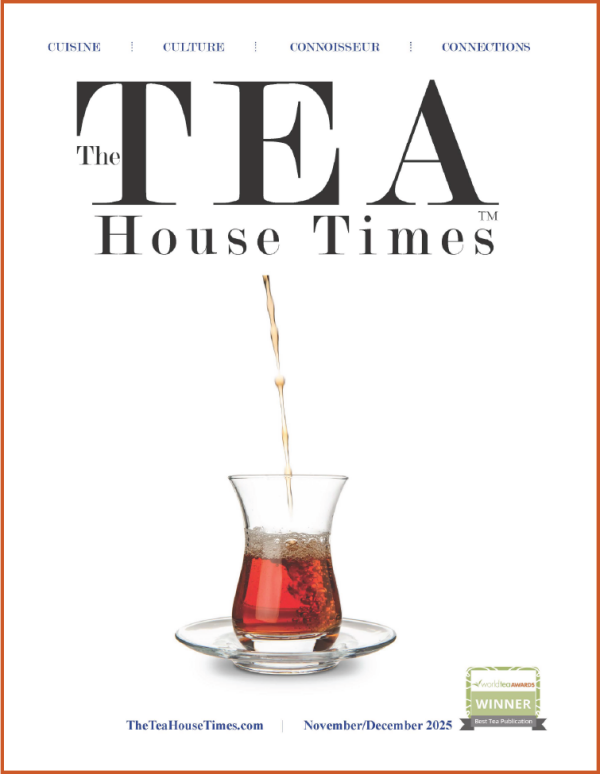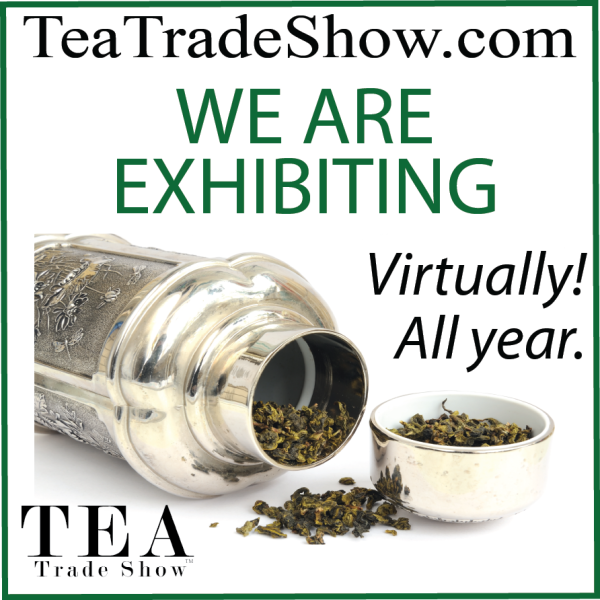

 by Gail Gastelu, Owner/Publisher, The Tea House Times
by Gail Gastelu, Owner/Publisher, The Tea House Times
 2018 TRADE SHOW Q&A with The Tea House Times
2018 TRADE SHOW Q&A with The Tea House Times
SHOW NAME: SIAL Canada
SHOW DATES & LOCATION/s FOR 2018: Montreal, Canada - May 2-4
SHOW DATES & LOCATION/s FOR 2019: Toronto, Canada
SHOW WEBSITE: https://sialcanada.com/en/
SHOW REGISTRATION DETAILS IN BRIEF: SIAL Canada is open to specialty food industry professionals. Those interested can register at: https://sialcanada.com/en/register/ USE CODE: SIALTEA18 for 50% off reg.
SHOW DESCRIPTION IN BRIEF: SIAL Canada is the largest international specialty food tradeshow in North America, showcasing the latest and greatest in culinary innovation from all over the world with more than 1,000 exhibitors from over 50 countries attending to take part. SIAL Canada is truly a fantastic resource for a pulse-check on what's next in food, from the tradeshow event itself, to a panel of SIAL Canada experts covering a variety of relevant categories, to the annual Innovation Awards that celebrate the best new brands and products in the world-wide food market.
SHOW’S TYPICAL CATEGORIES OF ATTENDEES AND EXHBITORS – domestic/international?: International - Cheese & Microbrewery, Grocery, Beverages, Set, Market Fresh (more details: https://sialcanada.com/en/industry-sectors/)
SHOW OWNED OR PRODUCED BY: SIAL Group
SHOW OWNER NAMES: SIAL Group
SHOW MANAGEMENT / NAMES: SIAL Group
Q&A
Answered by: Jean-Sébastien Michel, SIAL 2018 Beverage Ambassador and president of Alambika and Jesemi Distribution, companies specialized in wine, beer, spirits and cocktail ingredients and accessories.
Q: What emerging trends do you see in the following beverage areas:
wine
The natural wine trend sure is going strong in cities like Montreal. There is a rediscovery of traditional, minimally transformed, no sulfur added, non-wood vessels aged (i.e. in clay pots) vintages. Those wines are by definition unstable and come with different levels of “funkiness”, the type frowned upon by large-scale producers in need of homogeneity. On the other hand, their fresh, light, unformatted and often surprising exuberance is charming an increasingly large crowd, unable to go back to the tannic and oaky canons they were used to drink.
Emblematic of this new wave are the so-called “orange wines” that have been produced for centuries in Slovenia, Georgia or the italian Frioul. They result from leaving the red grape skins macerating with the white for hours, days or weeks. Small producers from Canada, the USA, Australia and everywhere, really, are jumping on this revival. A lot of restaurants here only serve, at least, organic, but more and more, fully natural wine. It, however, comes at a cost; it is more difficult to serve by the glass without the rest of the bottle turning bad, the brettanomyce yeast is usually thriving in the wine give them a tell tale “farm” scent, which can become acquired taste. All in all, what makes it so appealing to some will definitely rebuke a more conservative or older customer base.
beer
The beer market has grown so fast in the last years! There is an explosion of breweries, some very small, each producing a larger number of always different beers. Basic, light tasting beer is not cutting it for an increasing number of consumers who got in touch with microbrewed products in the last decade. We also note an always diminishing loyalty toward brands or even a specific brew: beer enthusiasts want what’s new. Limited editions, collaborative beers, seasonal stunts, experimental tryouts, brewery bottle
releases days are currently driving the specialised beer market. In order to keep up with the trends, big beer consortiums now own departments looking for the best microbreweries to buy. Those newly acquired breweries gain a lot of means to expand their marketing, markets, logistic and production capacities, while keeping an image and products that cater to craft beer enthusiasts. Large beer corporations are then able to offer craft looking portfolios of beers in bars and restaurants where their traditional offering of brand names would be ignored.
Flavour-wise, hoppiness remains big. IPAs were all the rage few years ago, now what’s going strong are the “New England (or North East) IPAs,” with a hazy look and a juicy, citrusy or papaya like taste is the latest trend. Interestingly, those beers need to be drinked very very fresh (within a month) giving an edge to small, local producers over national distributors who face a logistical quagmire with such time constraint.
Beers with berries, generally sour, also gain traction. Noteworthy, like the citrusy or tropical IPAs, these beers makes for great gateways for people who never liked the standard, malty and cereal tasting beers.
spirits
Spirits keep on booming as well. In the last years, most new Canadian distilleries pumped out and sold white spirits, such as gin and vodkas. Those are great sellers and, most importantly, can be bottled right away. The big goal for most, though, is to release whiskeys, which need to be legally aged at least 3 years to gain the right to be named as such.
Canada is by all means a nation with a great distilling potential; excellent quality rye (a lot of US Rye whisky is made from our northern cereals), an almost infinite amount of corn, a climate allowing aging without too much evaporation, great quality water and a market of enthusiasts looking for local alternatives to imported classics. Indeed, if Europeans for long have taken inspiration in their liquors from their colonial days, we currently tend to look for unicity and authenticity by using what grows in our own soil.
A big trend is a celebration of northern ingredients: pine, parsnip, wild
berries, maple, hop, apples and so on. Also burgeoning, a care about the origin of the spirits as we see for other categories. Are they GMO free? Can we get organic gin? The singular thing with spirits is that distillation removes a lot from the initial ingredient. So what is exactly left? We know gluten doesn’t follow when wheat is distilled. But what about the rest?
coffee/tea
Coffee and tea both see some similar deep trends, as they became sort of twin beverage in occidental culture. Interestingly enough, the major push I see with these beverages is from a bland “middle ground” and into either highly convenient and fast or very slow and ritualistic peripheries. On the one side, big coffee industry players develop apps to order your coffee so it is ready when you cross the door at Starbucks and a Nespresso machine allows you to pop a capsule and enjoy an espresso within 30 seconds.
On the other hand, third wave coffee roasters (selecting grain abroad and roasting it gently so terroir specific flavours remain) are proliferating, encouraging a culture of weighting by hand each dose, manually pouring water and using simple contraptions from another era like the Chemex coffee pot. The simple Cup of Joe is losing ground to either the efficient caffeine intake or the leisurely, almost zen, ritual of watching drops falling into a handmade clay cup.
There are also strong trends about making these products as healthy as possible. To remove caffeine, find organic supplies, herbal additives and so on in order to offer “clean labels” that will attract consumers with its sort list of quality ingredients.
flavoured carbonated and non-carbonated waters
This category is already big but will see tremendous growth in the coming years. Sodas and syrups to which you can add carbonated water have had a big reboot through on regional levels. In a way similar to beer, many local producers supply their own market. Water, sugar, CO2 and glass being expensive to ship compared to the final retail value of the beverage, low helps protecting the small local players from their other regional counterparts with limited capital. Many will in turn use identity based
marketing (name, flavours, local ingredients) to create a bond with their base market.
The latest trends keep pushing for healthier drinks, such as kombucha and drinking vinegar (shrubs) both having a balance of sweetness and acidity in order to refresh one’s palate. We will see many combinations of genres in this expanding market.
Q: What are the key factors behind the growth of these trends (e.g. changing demographics of consumers, growth of plant-based diets, economics, etc.)?
We want to live increasingly healthy lives and are more aware than ever that we are what we eat … and drink. We will still do excesses, but want those to be worthwhile taste and experience-wise. So we are getting more conscious as we “pick our poison”, so to speak.
There is also an increasing demand for drinks with no alcohol, limited sugar or caffeine, hence the growing successes of speciality drinks, mocktails and the like. The aging population is definitely a key factor here. Even some bartenders or sommeliers passed their thirties do not even drink anymore, yet they keep a social life. They want to drink something else that will bring them more joy than issues.
Something to keep in mind too: alcohol has always been the sole legal drug for people to enjoy and build a culture around within the bounds of the social norm. Now that the government has announced that marijuana will soon be legal, it is safe to say that a fair market enjoyed by alcohol producers will go to a new contender. They will need to monitor these changes closely if they want to remain at the top of their game.
Q: What differences do you see in drink preferences among North American consumers versus Europeans or Asian consumers? Why do you think these differences exist?
It would take too long to give a proper answer to this. I will, however, point
out that drinks are very interesting cultural ambassadors and a sphere where the local and the global intersect continually. North America is a great laboratory because it still has a relatively young beverage culture which, in case of alcohol, has almost been uprooted literally (vineyards touched by Phylloxera) and culturally with the alcohol prohibition and its remnants. A lot is being rediscovered from our past (think of the whole current cocktail scene) as well as taking inspiration from the Old Continent.
A good example is beer; Germany has its classic styles which in their case have traditionally been defined by law, so do the Belgian and the Czech with their own signature techniques. There are unorthodox breweries in all those countries for sure, but North America has taken a syncretic approach where being all over the place, stylistic wise, has become the main characteristic in itself.
Q: What merchandising advice for beverages can you provide to grocery retailers?
The new products are more qualitative or, at least, complex than they use to. Milk can only be discovered once. People who are given a chance to taste value added products, especially when locally produced, have much more chance to buy. This is especially true when the category is new or hybrid (coffee-cocktail, sparkling herbal tea, etc.) Everybody knows coffee. But a herbal sweetened cold brew or a maple and apple shrub can be puzzling and paralyze a potential buyer if no one can explain what it is all about or have them sample this new brew.
It is also important customers understand the context for which those products are designed and the multiple or specific uses they can have. For example, let’s go back to shrubs. They are a mix of juice, vinegar and sugar. Also called “drinking vinegar, they can be used in cocktails, soft drink bases, salad dressing, deglazing and so on. Signs, leaflets, sales people training or tastings are the best way to get the customers understand what’s on the shelves.
It is important to note that merchandizing will be a focus of the SIAL this year. Experts have been invited on panels to answer questions about this and talk about the latest trend. An extra reason for not missing this edition!
Q: What does SIAL Canada plan to do to help the drinks segment of the exhibition?
Drinks are a new category at the SIAL, as your question suggests. In order to make the best out of this important addition, we have gathered panels of experts who will help industry actors across beverage types on diverse topics. There will be cross promotions of use between spirit makers and sodas or cocktail ingredients. We have planned special booths were specialists will showcase ways to add value such as a clear ice cutter making perfect cubes for cocktail bars, a glassware specialist explaining how different formats make the drinks look better and the glassware last longer, impress with latte art or flair juggling and so on.
We are really enthusiastic about all this; I am sure it will feel as the beverage part has been there for years. We really want to give it the place it deserves. After all, what would be the point of preparing good meals without the possibility of enjoying the proper accompanying beverages?
Answered by Magalie Moreau, Marketing and special events Director
What is new at SIAL Canada this year? . . And is it something offered this year only or expected to continue?
A new sector dedicated to beverages.
A significant Ambassadors network that is going to exist again and again!
A bunch of activities that brings a significant added value to the food industry. This year a special emphasize on the ready-to-eat trend within the umbrella of the food revolutions.
What do you consider the best opportunity for networking at your show? (i.e. the show floor, after-hours events, awards, etc.)
B2B meetings are the most popular from an exhibitor point of view. From a visitor and media perspective the SIAL Innovation contest is definitely the most attended event revealing the best food innovative products including the food packaging ones.
As to after-hours events the SIAL Canada networking event to be held in the evening (by invitation only) is also more and more popular for the ones who are looking for international contacts. Indeed SIAL Canada is the only show in North America that offers such a big variety of products / companies in one single place.
Finally Group Export networking cocktail is very well known within the industry for gathering major food industry players and influencers.
How is your education during the show organized? by tract? topic? industry niche? workshops? seminars? demos? on floor presentations?
Educational sessions, panels, workshops are everywhere on the show floor in the respect of the sector of activities. Indeed SIAL Canada offers a unique sectorization that makes the experience more enjoyable. Cheese workshops on the cheese sector, Inspire Drink (beverages workshops) in the beverages sector, etc…
Please note that most of the conferences will be offered in 2 different rooms at the 5th floor.
How are these education opportunities priced? a package price? per session? all free? In general… and provide link to further details.
Most of the activities are available on line for purchase. Some of them are accessible for free. Don’t wait longer and click on the link below to learn more and register!

- - -
Click for more eNews + Blog Archives
© All content + images copyright of news/blog providers.
- - -
NOTE: The inclusion of news or advertising in The Tea House Times publication, on our website, or in our online eNews does not constitute endorsement.
- - -
POSTS SPONSORED/PUBLISHED BY TheTeaHouseTimes.com
Weekly eNews is circulated via email. Join list at top of home page.
The Tea House Times is published 6x per year in print & digitally.
INFO - SINGLE ISSUES | SUBSCRIBE | ADVERTISE | CONTACT
SOCIAL MEDIA - Follow us @teahousetimes
EDUCATION OPTIONS-
TeaCourse.com | TeaEtiquetteCertified.com | TeaCourseFastTrack.com
SHARE THIS ↓



